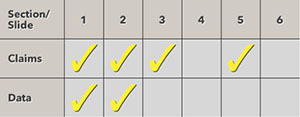E-detailing data management
Two approaches
There are two basic approaches to e-detailing and closed loop marketing data management:
- Track to see how your sales force uses the presentation
- Collect information on how your customers receive the information
Both of these approaches – “track the delivery” and “track the response” – provide critical insight into your marketing.
Tracking message delivery
Many companies start out by tracking the presentation delivery. Monitoring usage is an easy first step, allowing you to see which parts of your presentation are being shown to healthcare professionals.
To give a very simplified example of this process, imagine that your e-detailing materials have just six parts or ‘slides’.
Simplified slides tracking
Divide each slide into claims and the clinical data that these claims up:
Now start to see how the presentation is being used in the field:
Here the usage seems good at the beginning of the presentation, with both the claims and the data being shown. Then, on Slide 3, the claim is shown but not the data. After that it falls away rapidly, with only the claim on Slide 5 being shown.
Even this very simple kind of tracking can be very useful. First you get to understand what your customers are seeing. This can be very important if, as in the example shown, your key arguments were on Slide 4.
It also gives you areas to investigate. In our example, interest disappears on Slide 3. Why might this be? Is this something to do with what the reps say or perhaps there is a basic content issue?
Tracking message delivery won’t provide all the answers. But it can help identify problems early on, so you can take action.
Tracking customer response
The second kind of data tracking tells you more. By monitoring how customers are interacting with your presentation materials you not only know whether a slide has been shown but also what healthcare professionals think about it.
This feedback is achieved through interactivity. You encourage healthcare professionals to engage with the presentation. This not only makes the e-detailing more involving but means that you are getting a response which provides quality data and insights into customer understanding.
The good news is that it doesn’t have to be complex. You can start with a few well-designed interactions at key points and learn a great deal about whether you are achieving your communication goals.
Customer tracking example
Your exact process will depend on how your organization is structured and your precise data needs. Yet, as a general rule, most CLM data projects follow similar steps:
1 Defining your data needs
This will depend on your business needs, though often focuses on tracking where customers are on the ‘adoption curve’ – so that you can see the extent to which customer understanding and belief in a treatment has been affected.
2 Applying data capture to your content
The presentation materials should be designed to allow for data collection following your defined needs. Specialist CLM creative agencies can provide the interaction-rich content that this requires.
3 Data collection and analysis
Following customer interaction with your presentation materials, raw data then flows to Business Intelligence. This is then analyzed and visualized to allow for discussion.
4 Determining your response
Business Intelligence then feedback to Marketing and Sales. Key conclusions are drawn to allow for revision of existing materials and to inform new campaigns.
5 Updating your data needs
Often initial market feedback uncovers specific questions prompting new data needs. These are then incorporated into the presentation materials.
Webinar: Get results from digital sales enablement
Experience how to get started on, or advance, your digital sales enablement journey in a fast, easy and risk-free way.
10 essential data questions
Good data management is essential for CLM and e-detailing. The heightened customer understanding that efficient data processes provide can transform your marketing.
Do I want to track just message delivery or also understand the customer response?
What are my data needs?
What is the most important thing to learn?
What parameters require immediate intervention?
What internal communications processes do I need to set up?
Does the data go into a dedicated reporting tool (e.g. Rainmaker Revealer) or an internal system?
How should the data be provided?
What kind of reports and views are required?
How will the CLM system be integrated internally?
Who needs to see the reports and what is the scope and timing of my follow up?
Get more CLM guides
Go back to the main 'Get Started' page for more closed loop marketing guides.
Never miss a thing
Join our email mailing list and receive all Agnitio articles and digital marketing guides as soon as they are published.















